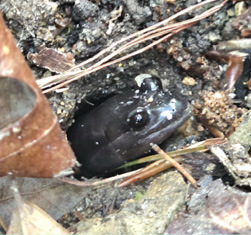Hunters Arrive Where Salamanders Thrive

In a rural region of southwest Alabama lies an area known for its unique biological communities housed within steep forested slopes with outcroppings of siltstone in the Tallahatta and Hatchetigbee formations of rust-colored soil commonly referred to as the Red Hills region of Alabama. Within the steep slopes of this unique habitat resides Alabama’s State Amphibian, The Red Hills Salamander (Phaeognathus hubrichti) (RHS). First discovered in 1960 in Butler County, Alabama, this quite large (up to 11 inches) lungless salamander represents the sole member of its genus and is unique because of its terrestrial burrowing. Adding to its uniqueness, the RHS has a very narrow global range existing only within the Buhrstone/Lime Hills Region in south-central Alabama in a strip stretching from the Alabama River in the west to the Conecuh River in the east. This area consists of only a few counties in the state, where RHS appear to be strongly associated. The RHS was listed as federally Threatened under the Endangered Species Act in 1977. Loss of habitat is the primary threat to most species listed as endangered or threatened under the Endangered Species Act (ESA), including the RHS. Land acquisition is often the most effective and immediate means of protecting habitat for wildlife species, particularly in areas where development or land uses are inconsistent with species recovery that threaten to destroy, modify, or curtail key habitat attributes.
In response to growing concerns over the loss of RHS habitat, the Alabama Department of Natural Resources Wildlife and Freshwater Fisheries Division (WFF), State Lands Division, the Forever Wild Land Trust, U.S. Fish and Wildlife Service (USFWS), and other partners worked and are continuing to work cooperatively to acquire key parcels containing RHS habitat to permanently protect populations of RHS. The partners’ success stemmed from the Recovery Land Acquisitions (RLA) grant program, administered by the USFWS, available to states and U.S. territories, on a competitive basis, to purchase lands to protect threatened and endangered species. These RLA programs, funded through the Land and Water Conservation Fund, were first awarded in 2001 and are authorized through the Cooperative Endangered Species Conservation Fund. The RLA programs promote state and federal cooperation in listed species conservation by leveraging funds to acquire specific parcels of land, through fee simple or conservation easement, in support of USFWS approved species recovery plans and outlines. In Alabama, RLA grant programs, coupled with matching funds from the Forever Wild Program, have played an important role in protecting wildlife species including federally threatened RHS.
Since the initial purchase of 4,500 acres, WFF and Forever Wild have continued this partnership to purchase approximately 13,500 acres of land in the Red Hills region creating the newly formed Red Hills WMA. Most public land users utilizing Alabama’s public land system usually haven’t a clue how the lands they use to pursue their outdoor recreation activities are purchased. The Red Hills WMA not only protects imperiled wildlife species, like the RHS, but also provides the public a variety of outdoor recreation opportunities. While these benefit activities such as hunting and other outdoor recreation, it also removes the regulatory burden from private landowners as these lands are now protected in perpetuity and align with the WFF mission to protect, enhance, conserve, and manage the wildlife resources of the state, including both game and nongame species. When the state purchases land, it is a win/win for hunters, bird watchers, hikers, etc. as they now have access to public recreation lands while also providing protected and managed lands for a variety of imperiled species.

